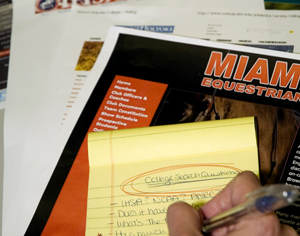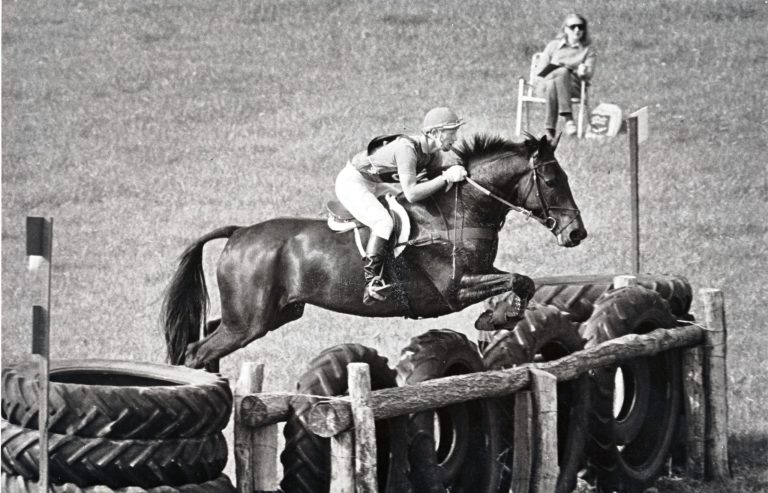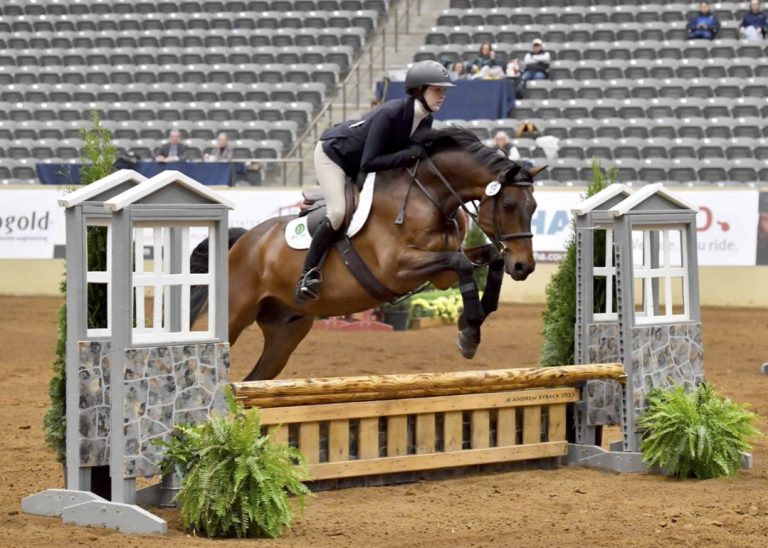Given the myriad choices available, you can never start thinking about college too early. That’s even truer if you want to ride horses while earning your degree. Typically the search starts during the freshman and sophomore years of high school, though it can start as early as middle school. Ideally a few final targets are locked in by the fall of junior year.
 ? Stacey Nedrow-Wigmore | Practical Horseman
? Stacey Nedrow-Wigmore | Practical HorsemanNo matter when you get started, there are a mind-boggling number of options and considerations. Having received hundreds of inquiries in her 10-plus years immersed in the collegiate equestrian world, Miami University of Ohio Equestrian Center Director Lori Cramer says there are many questions to ask prospective colleges and universities. But first there are several to ask yourself, none of which are riding related.
Academic programs, geographic location, tuition, cost of living and size of the student body are among the first facts to know in determining whether a college is a good fit for you. Seemingly unimportant details, such as the population and character of the school’s surrounding town or city, can have a big impact on your happiness over the course of your college years, Lori notes. She sometimes encounters students who focus only on a school’s equestrian offerings, and that, she says, is a recipe for disaster.
With the big-picture inquiries answered, the next question is, “What kind of riding do I want to do during college?”
“There are so many schools with riding programs and so many ways to ride at school,” notes Lori, an Intercollegiate Horse Show Association board member and IHSA Zone 6 chair. The choices range from taking a weekly riding lesson as a physical education class to earning a scholarship to ride competitively on the school’s equestrian team.
The “Venues”
The US Equestrian Federation is affiliated with four collegiate equestrian organizations or “venues” as Lori calls them. Founded in 1967, the Intercollegiate Horse Show Association is by far the largest with 370-plus participating colleges and universities. Twenty-three schools offer National Collegiate Athletic Association teams, 44 have Intercollegiate Dressage Association squads and there are 39 teams sanctioned by the American National Riding Commission.
IHSA and NCAA schools typically offer Hunt Seat and Western riding, while IDA serves dressage enthusiasts. As part of its effort to promote a systematic approach to riding, training and teaching, ANRC stages clinics, certifications and hunter competitions called Equitrials.
As a general rule, IHSA offers divisions for the widest range of experience: eight levels in Hunt Seat and six in Western. Spots on NCAA teams are most often sought by riders with stellar show r?sum?s, but some schools are receptive to those with little to no competitive mileage.
In competitions sanctioned by IHSA, NCAA and IDA, you ride unfamiliar horses provided primarily by the host school.Another big common denominator is that you are allowed little to no time to practice with or school your mounts before entering a class.
Lori stresses that each venue has its own rules. NCAA, for example, has strict guidelines regarding communication between prospective coaches and students, eligibility rules that involve amateur status and prize money, and other regulations that you must research thoroughly before signing on.
Beyond that, even schools with teams sanctioned by the same entity have vastly different arrangements, requirements and riding and financial-aid opportunities. The search can be complicated, but think of it as a great chance to apply academic research skills to a critical real-world decision.
Be polite and prepared when making in-person, phone or e-mail inquiries of a coach, team member or administrator, but don’t be shy. Recruiting new riders is an important component in every school team’s ongoing success, and you might be just the student a coach is looking for.
The Internet is a goldmine of collegiate equestrian information. IHSA, NCAA, IDA and ANRC websites (see Websites box) will link you to most of the schools that offer riding programs. Most teams have their own Websites, which promote the benefits of joining their programs and provide varying details of what membership entails.
Firsthand Experience
When you’ve found a handful of schools that seem a good fit for your criteria, the next step is sussing the qualitative information you won’t find on the Internet. What does the school’s facility look like? What sense of camaraderie do the riders have? What is the coach’s teaching style?? Lori offers the following tips for this phase of your search:
Vacation smart. “As you plan your family vacations, start thinking about colleges you could visit in the area,” Lori advises. “We get a lot of people here who are visiting family or on vacation. Often they are still in middle school, but it’s a great way to check out the program, especially if you are considering a school that’s far away from where you live.”
Call ahead to schedule your visit. If the coach is unable to show you around, most schools have team members who serve as enthusiastic and well-prepared prospective student liaisons. Spring is when teams are polishing up their acts for the year-end championships. A visit during this season will give you a glimpse of the team at its peak, but it might be tougher to get quality time with a coach.
Visit summer camps: Consider attending a summer camp hosted by a college you’re interested in. Typically run by the school’s coach and staffed by team members, this is a terrific way to evaluate the program’s teaching style and horsemanship approach and to test ride its horses. Just like the opportunities during the academic year, the nature of summer programs varies widely. In most cases, you will ride the school’s mounts, but some allow you to bring your own horse.
Go to a show. Attending a collegiate competition as a spectator is one of the most underutilized methods of scouting an equestrian program, Lori says. “It’s a fabulous opportunity to see riders and their coaches in a group setting.” Each of the four USEF-affiliated collegiate riding associations has annual national championships and the IHSA has regional events, too. You can check out several schools at the same time without the time and cost of crisscrossing the country.
Look for each school’s logo on horse-and-rider attire and study the event program to zero in on the teams that most interest you. Coaches might be too busy to talk to you then, but there is no harm in approaching them politely if you catch them in a quiet moment. Even if that opportunity doesn’t materialize, you can glean a great deal from buttonholing riders and parents on the sidelines. Simple observation will tell you a lot, too. “Watch how the riders interact with each other and cheer each other on,” Lori suggests.
Any of these firsthand experiences with prospective schools and riders should help narrow your search further. Now it’s time to get specifics regarding time and financial commitments and details about the realities of representing that school as an equestrian.
Time Commitment
Managing riding with the high-school grades and extracurricular activities necessary to earn college admittance is a great indicator that you’ll be able to handle a similar juggling act in college, but it’s important to find out about required time commitments. Twice-weekly one-hour riding lessons for Miami University’s 75-100 team members, for example, become a four-hour commitment when you factor in preparing and putting away the horse. That doesn’t include another two hours a week of nonriding workouts.
Ask about flexibility. Lori can often juggle lesson schedules so students can swap preparation and put-away tasks to accommodate their class schedules.
You also want to find out if the school’s equestrian center is on or off campus. Some outsource their riding program to a private barn in the area. How will you get there, and how long will that take? At some schools, the teams in the Hunt Seat, Western and dressage disciplines are based at different locations, so take that into consideration if you hope to compete on multiple squads.
Competitions will consume much weekend time, cutting into studying. The Miami team typically travels to four or five shows a semester and hosts two to three each year. NCAA schools have only one level of competition. For Hunt Seat teams, this is broken into flat and over-fences classes. The end result is each show takes only one day or less. But this time savings is often offset by weekend road trips during which riders compete against two or three colleges.
Find out how often the schools you are interested in compete. Keep in mind that, even if you are not showing, team members are usually required to go anyway to help care for the horses, prepare fellow teammates and cheer on each other.
Just as in high school, competing means academic absences. Try to elicit the attitude of professors toward classes missed for riding. Schools that treat riding as a varsity sport are most likely to have cooperative attitudes from academic professors. Ask whether the equestrian coach can or will intervene on your behalf if need be.
Cost Considerations
The economic appeal of all collegiate riding programs is that you don’t have to own your own horse. One of IHSA’s founding principles was to make riding available to all, regardless of financial means. However, a literally free ride is rare.
How a school designates its equestrian program is the first determinant in the expenses involved. “Varsity” status means the program is recognized and funded by the school’s athletic department. Lessons, shows and related travel expenses are covered by the school along with whatever supplemental workouts are required.
“Club” status generally means student fees pay for the program. However, several IHSA schools have varsity teams, and many of those clubs receive significant school funding, thus reducing the students’ expenses. Miami University’s team is a club squad “partially funded” by the school. Redhawks riders pay a fee per semester that covers all lessons, use of the horses and equipment, their coach’s and their own travel expenses to shows and the cost of staging two or three competitions each year at their equestrian center.
Schools provide horses and tack, but students need formal show attire in most cases. Lori advises her incoming team members not to buy anything new before arrival. Sharing, swapping and renting show wear from the club are among the affordable alternatives to buying new.
Scholarship opportunities of all sizes exist with equestrian teams sanctioned by any of the collegiate equestrian groups. Talk to the coach, the school’s financial-aid department and other parents and students to research the possibilities.
Taking your own horse to college is sometimes possible but considerably more costly. You won’t be able to use him in collegiate competition because it violates rules that seek to level the playing field between riders. NCAA riders must be very careful to maintain their eligibility if they campaign their horses, or other people’s horses, in prize-money classes on the open (noncollegiate) circuit. Some schools may be willing to lease or half-lease your horse for use in their physical education and/or lesson program.
The onus is on you to get an accurate estimation of costs at each school you are interested in attending. “Check the Websites, request a newsletter and call the school and the club contact for a fee structure,” Lori advises. “Tell them you are looking at their college and ask them what financial information they can provide you with to help you create your college budget.”
Competitive Expectations
“Riders who have been actively showing and having great success need to feel they’ve found a school whose team matches their level of competitiveness,” Lori says. But don’t be surprised if your definition of competitiveness is altered by the collegiate riding experience.
“Many of these riders have never competed as part of a team before,” she says. “This is an opportunity to have more than yourself as part of the end result.” Elite riders may not be jumping as high or facing such high-level competition in collegiate competitions as they did as Juniors, but the camaraderie, teamwork and leadership opportunities are powerful counterbalances for many.
The most talented and seasoned equestrians are often tapped to help bring along the team’s green horses and riders. “For anybody who’s ridden at the upper levels, being able to get on different horses and produce results quickly to the best of that horse’s ability is something that most find very interesting and challenging,” Lori notes.
Growth opportunities abound for riders at every level. When Redhawks riders “point out” of their division, Lori charges them with helping the next riders to fill their shoes. For entry-level Walk/Trot contenders, that may mean recruiting a newbie and, at the higher levels, it means helping those less experienced learn the next level’s ropes.
Not all team members compete in every show. Jumping divisions are often the most limited. At a typical IHSA competition, for example, each school may be limited to entering only eight jumping riders and 25 flat riders. Horses can be schooled only by noncompetitors, so that gives more members an important role at the event, and plenty more are needed to help care for the horses and assist teammates. Ask your prospective schools how many team members typically get to compete in the divisions in which you are interested. If it is not 100 percent, find out how the competitors are selected.
Determining whether and how you will be one of the thousands of riders who join their school’s equestrian team is not for the faint of heart. But it’s likely that the rewards will justify your efforts, and participation will be a highlight of your higher-education experience.
Click HERE to learn more about the various school riding programs.
This article originally appeared in the December 2009 issue of Practical Horseman magazine. To learn about the College Preparatory Invitational, see the April 2011 issue of the magazine.










